The 2015 MacBook Review
by Ryan Smith on April 14, 2015 10:15 AM ESTWindows Performance
Shifting gears from OS X, let’s take a look at performance under Windows. Though not every MacBook will be used with Windows, Windows gives us a wider selection of benchmarks to work with, and it gives us a chance to compare the MacBook to some contemporary PCs.
For our Windows comparison I’ve pulled in a number of results from our most recent Core M review, including other Core M laptops, the Haswell-U powered Surface Pro 3, and a couple of Broadwell-U powered laptops. Of particular interest is likely the Asus UX305, which is another Core M based laptop that uses a very similar build. At 13.3” it’s larger than the MacBook, but it is a similar aluminum fanless design.


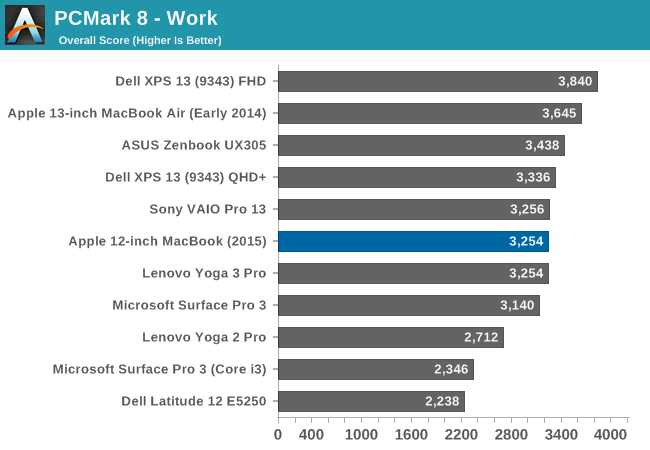
Depending on which sub-test we’re looking at, the PCMark workloads are a mix of bursty workloads, lightly threaded workloads, and heavily threaded workloads. As a result the MacBook and its Core M processor are given some opportunity to show off, and at other times is pushed back due to its cap on sustained performance.
The Home workload is one such light test, which plays into the MacBook’s favor. Here it’s towards the top of the charts, surpassing everything other than the Core M based Asus UX305, and then the more powerful Broadwell-U based Dell XPS 13s. I keep rattling on about workload types and this is a good example of why it matters, because in a light workload the MacBook is among the fastest of the ultra-portables, beating out many other Core M devices and also some Haswell based Ultrabooks. Put another way, in a light workload Core M can already deliver (and at times exceed) one-generation old Haswell Ultrabooks.
As for the Creative and Work workloads, the MacBook still places relatively well. Doing this well on the Creative workload was a bit of a surprise, since it’s the most demanding benchmark of the 3. I suspect we may be seeing a mix of dividends from the SSD and Core M’s GPU, Otherwise the lighter Work test actually has the MacBook farther behind the pack, with performance in-line with other Core M laptops, though not as exciting compared to the Ultrabooks.
Overall, between our OS X and Windows CPU benchmarks, what we’re finding is that the performance of the MacBook generally mirrors our expectations given what we know about its design and component selection. Given a light workload that allows the Core M CPU inside of the MacBook to turbo to its fastest speeds, it’s a very potent competitor in a small package, able to give all but the most recent Ultrabooks a run for their money. However heavier, sustained workloads drive a wider gap in between the two classes of devices, and in those cases the MacBook offers performance closer to Ultrabooks a 3-4 years old.
Shifting gears one more time, let’s take a look at GPU performance. GPU workloads present an interesting scenario for Core M, and by extension the MacBook. The underlying Intel HD Graphics 5300 GPU is a GT2 configuration, making it moderately powerful for an iGPU, however the power and thermal constrains on the MacBook means that the laptop doesn’t have the power required to run a GT2 GPU at full speed.
With the Broadwell CPU cores alone able to chew up 4.5W and then-some, a combined GPU+CPU workload will generally put the MacBook in a pinch. Consequently I don’t see the MacBook being used as any kind of gaming machine – the MacBook Air is undoubtedly a much stronger contender – but it’s useful to put this performance in context.
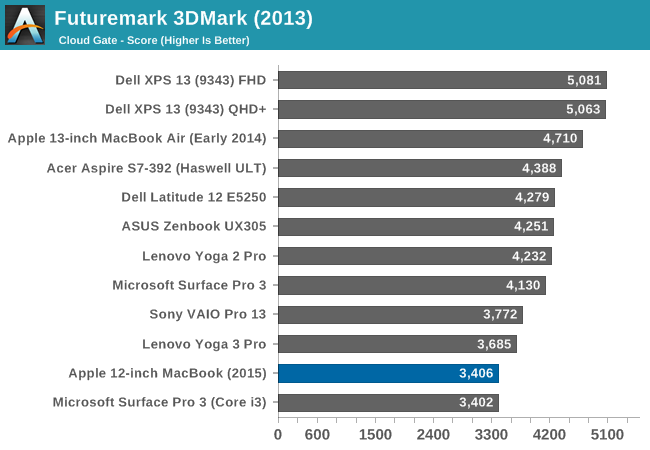
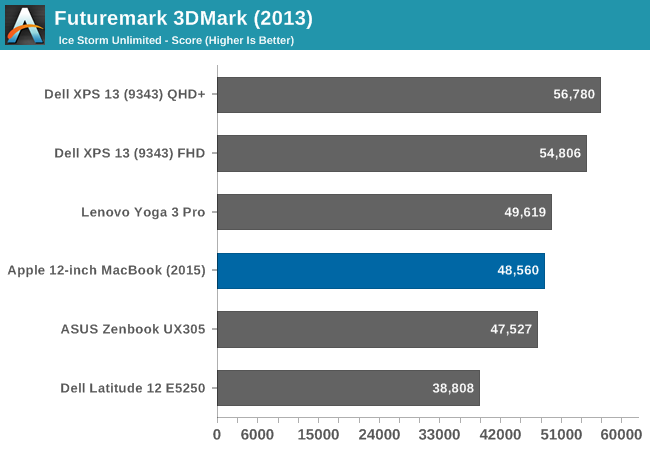
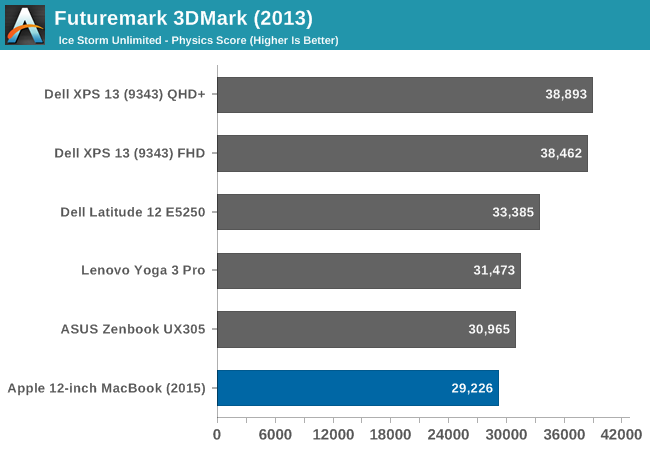
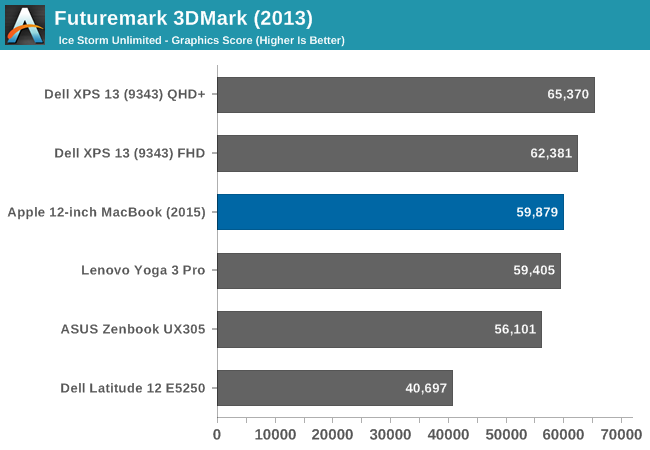
Our 3DMark scores handily illustrate this exact point. Facing significant power and thermal limits, the MacBook has to pull back in performance and consequently ends up near the bottom of our charts, versus its much better showing in PCMark. The 2014 MacBook Air 13” is some 38% faster at Cloud Gate, and on the newer Ice Storm benchmark the results aren’t much better. Of the two it’s worth noting that Cloud Gate is a much more complex and longer running benchmark, whereas Ice Storm is a quick running tablet-sized benchmark. Consequently Cloud Gate throttles harder and sooner, which is why the MacBook does relatively worse there. Overall the MacBook doesn’t even beat any of the other Core M laptops, which is a bit surprising. But nothing here is quite like the MacBook, so it’s somewhat different in its combination of small size and aluminum chassis.
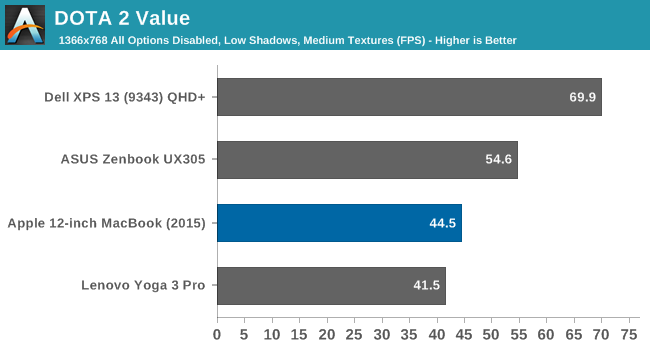
Meanwhile I have also run our DOTA 2 Value benchmark against our other Core M devices and the Broadwell-U based Dell XPS 13 for good measure. On an absolute basis 44.5fps is definitely playable for a game like DOTA, however on a relative basis this is a weaker showing than the UX305, not to mention the XPS 13. Compared to the UX305 the MacBook again appears to be throttling sooner and harder, whereas the Ultrabook-sized XPS takes full advantage of its higher power limits and better cooling.
Ultimately as we said when opening up our look at GPU performance, the MacBook’s GPU is potent on paper, but it simply doesn’t have the power and cooling capabilities needed to take full advantage of it. This means that while CPU performance isn’t too far removed from the Ultrabooks, GPU performance absolutely is.
Finally, I wanted to take one last look at performance relative to the tablets, this time from a GPU perspective.
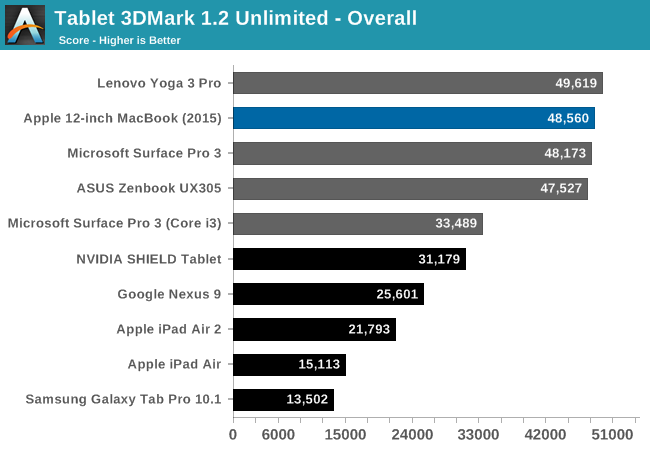
While the iPad Air 2 makes a good run on the MacBook in the web benchmarks, it and the other tablets are even more power limited than the MacBook, and as a result their GPU performance is even more constrained. The MacBook still has a better than 2x lead on the iPad Air 2 in this GPU benchmark, so judging from this it will be some time yet until an iPad's GPU performance catches up with this MacBook's.










354 Comments
View All Comments
TEAMSWITCHER - Friday, April 17, 2015 - link
The $1599 - 1.2GHz - 512GB model is ~5K, in Geek Bench 3.The "Actual Work" comment cracks me up. I have successfully done 3D web-plugin development for a major company on an 11" MacBook Air. I'm pretty sure I could have done the same thing with a 12" MacBook...probably even a little better.
milkod2001 - Monday, April 20, 2015 - link
3D web-plugin development could probably be done on entry level laptop :). By actual work i've meant working with many layers, exporting to high rez tiffs, pdf, a bit of video production on the go etc.This is not where new MAcbook will serve very well. That's for less then 5% of potential Macbook buyers though, so im sure many(including you) will be more then happy with this new Macbook.
vampyren - Thursday, April 16, 2015 - link
This is just a shitty laptop, underpowered, useless with one port.Apple should have added the screen, keyboard, touch-pad on Air and everyone would been happy.
There is a limit to how thin you can make things before they become useless.
I love my MBP and was going to get the updated Air had they added retina on it but they sadly made a useless version instead.
hummerchine - Thursday, April 16, 2015 - link
I'm constantly amazed at some of the fervid anti-Apple comments on this and other forums! This review was fantastic and right on...the best I've seen, and I've been seeking them out (AnandTech does a great job, as did this reviewer). The new MacBook is highly desirable for the right person...that would be me. I've ordered the best, most tricked-out model. Is it a desktop replacement? It was not intended to be! If you want a desktop with more power, or even a portable with more power...Apple and many other companies offer many other options. If you want a crazy light awesome travel computer, this is as good as it gets! The complaints about performance just blow my mind. They have crammed in the best processor, screen, keyboard, trackpad, batteries, whatever you can mention into the smallest and lightest laptop human beings can currently design. And some are whining about it? Jeez...just think about what you are saying! And if you really hate Apple's operating system so bad (my personal favorite, but I can see that is personal preference) there are competing Windows products with the same technology limitations. If you are like me and like Apple's OS, just how could they have possibly made this thing any nicer? Well...they probably could have squeezed in another USB C port or perhaps a small MagSafe connector. I suppose even more RAM might have been nice. A faster processor would be nice too...but isn't the Intel Core-M the fastest processor currently available that will fit into something so small, have good battery life, and not require a fan? Come to grips with reality some of you...that review was very accurate and well done, and I can't wait to get my new laptop! The millions of buyers of these things don't have to listen to you...they vote with their wallets! Btw, I'm very pleased to also be a stockholder.kdalkafoukis - Friday, April 17, 2015 - link
Does anybody knows any real performance details like?how many open pdfs can u have for example?
or
in which kind of programms you are gonna have problems(annoying performance)?
cgpublic - Friday, April 17, 2015 - link
I checked the new Macbook at the Apple Store. I'm a marketing professional with a a 2011 MBP 15" quad-core, 2012 MBA entry-level, and a the latest Mac Mini w/i7 dual-core in my toolkit. Apple is once again ahead of the curve, which is what they can afford to do, while other manufacturers have to design to ensure they don't leave any checkboxes unchecked. Which is why companies such as Dell are who they are, and Apple is choking on cash. People will pay good money for a taste of the future, and this is the future right here.For 95% of what I do, the Macbook Core M + good WiFi signal can manage with ease. Photo-editing can be done in a pinch w/Adobe CreativeCloud. Once you pick it up, you have to have it, and everything else is yesterday's news.
If you're primarily playing games and fapping on your PC, I guess processing power and wired connectivity is a big deal, but I earn for a living, in the real world.
tecsi - Saturday, April 18, 2015 - link
Prediction: the new MacBook will shortly outsell the 11" MBA, the 13" MBA and the 13" rMBP. Why? Dramatically better than both MBAs and priced about the same when configured with 8TB RAM and 256GB SSD. Half the weight of the rMBP, cheaper and with most of the feature set of the except for CPU speed. But for those notebook users that need performance, they will jump to 15" rMBP with its max performance.tecsi - Saturday, April 18, 2015 - link
Make that 8GB RAM, not 8TBtecsi - Saturday, April 18, 2015 - link
Two items not really clearly mentioned, but one crucial and another useful via-a-via the MBAs.First, and most important, I find I can productively use the MacBook display at 1920x1280 (with SwitchResX). This offers 266% of the screen real estate of the 11" MBA, an enormous, work-changing difference.
Second, but more minor, the new MacBook's Trackpad is ~25% bigger than the 11" MBA, providing easier, more accurate cursor movement and positioning.
jameskatt - Sunday, April 19, 2015 - link
The fact that Apple's slowest Macbook has the fastest SSD performance means the next Macbook Pro 15-inch Retina Update is going to HAVE A BLAST with huge unencumbered SSD speeds. Coupled with a 2 TB size increase and hopefully 32 GB RAM and 4K screen, this bar will move up further.